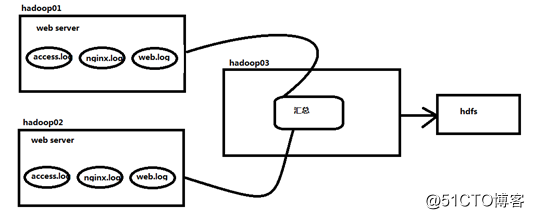需求:A B两台日志服务器实时生产日志主要类型为access.log、nginx.log、web.log,现在要求:
把A、B机器中的access.log、nginx.log、web.log 采集汇总到 C 机器上然后统一收集到 hdfs中,但是在hdfs中要求的目录为:
/source/logs/access/日期/**
/source/logs/nginx/日期/**
/source/logs/web/日期/**
场景分析:
规划:
hadoop01(web01):
source:access.log 、nginx.log、web.log
channel:memory
sink:avro
hadoop02(web02):
source:access.log 、nginx.log、web.log
channel:memory
sink:avro
hadoop03(数据收集):
source;avro
channel:memory
sink:hdfs
配置文件:
#exec_source_avro_sink.properties
#指定各个核心组件
a1.sources = r1 r2 r3
a1.sinks = k1
a1.channels = c1
#r1
a1.sources.r1.type = exec
a1.sources.r1.command = tail -F /home/hadoop/flume_data/access.log
a1.sources.r1.interceptors = i1
a1.sources.r1.interceptors.i1.type = static
a1.sources.r1.interceptors.i1.key = type
a1.sources.r1.interceptors.i1.value = access
#r2
a1.sources.r2.type = exec
a1.sources.r2.command = tail -F /home/hadoop/flume_data/nginx.log
a1.sources.r2.interceptors = i2
a1.sources.r2.interceptors.i2.type = static
a1.sources.r2.interceptors.i2.key = type
a1.sources.r2.interceptors.i2.value = nginx
#r3
a1.sources.r3.type = exec
a1.sources.r3.command = tail -F /home/hadoop/flume_data/web.log
a1.sources.r3.interceptors = i3
a1.sources.r3.interceptors.i3.type = static
a1.sources.r3.interceptors.i3.key = type
a1.sources.r3.interceptors.i3.value = web
#Describe the sink
a1.sinks.k1.type = avro
a1.sinks.k1.hostname = hadoop03
a1.sinks.k1.port = 41414
#Use a channel which buffers events in memory
a1.channels.c1.type = memory
a1.channels.c1.capacity = 20000
a1.channels.c1.transactionCapacity = 10000
#Bind the source and sink to the channela1.sources.r1.channels = c1
a1.sources.r2.channels = c1
a1.sources.r3.channels = c1
a1.sinks.k1.channel = c1#avro_source_hdfs_sink.properties
#定义 agent 名, source、channel、sink 的名称
a1.sources = r1
a1.sinks = k1
a1.channels = c1
#定义 source
a1.sources.r1.type = avro
a1.sources.r1.bind = 0.0.0.0
a1.sources.r1.port =41414
#添加时间拦截器
a1.sources.r1.interceptors = i1
a1.sources.r1.interceptors.i1.type=org.apache.flume.interceptor.TimestampInterceptor$Builder
#定义 channels
a1.channels.c1.type = memory
a1.channels.c1.capacity = 20000
a1.channels.c1.transactionCapacity = 10000
#定义 sink
a1.sinks.k1.type = hdfs
a1.sinks.k1.hdfs.path=hdfs://myha01/source/logs/%{type}/%Y%m%d
a1.sinks.k1.hdfs.filePrefix =events
a1.sinks.k1.hdfs.fileType = DataStream
a1.sinks.k1.hdfs.writeFormat = Text
#时间类型
a1.sinks.k1.hdfs.useLocalTimeStamp = true
#生成的文件不按条数生成
a1.sinks.k1.hdfs.rollCount = 0
#生成的文件按时间生成
a1.sinks.k1.hdfs.rollInterval = 30
#生成的文件按大小生成
a1.sinks.k1.hdfs.rollSize = 10485760
#批量写入 hdfs 的个数
a1.sinks.k1.hdfs.batchSize = 20
#flume 操作 hdfs 的线程数(包括新建,写入等)
a1.sinks.k1.hdfs.threadsPoolSize=10
#操作 hdfs 超时时间
a1.sinks.k1.hdfs.callTimeout=30000
#组装 source、channel、sink
a1.sources.r1.channels = c1
a1.sinks.k1.channel = c1测试:
#在hadoop01和 hadoop02上的/home/hadoop/data 有数据文件 access.log、nginx.log、 web.log
#先启动hadoop03上的flume:(存储)
flume-ng agent -c conf -f avro_source_hdfs_sink.properties -name a1 -Dflume.root.logger=DEBUG,console
#然后在启动hadoop01和hadoop02上的命令flume(收集)
flume-ng agent -c conf -f exec_source_avro_sink.properties -name a1 -Dflume.root.logger=DEBUG,console转载于:https://blog.51cto.com/14048416/2343745




 本文介绍如何使用Flume从两台日志服务器实时采集access.log、nginx.log、web.log,通过Avro Sink汇集到第三台服务器,并最终存储到HDFS中。详细配置了Flume的Exec Source、Avro Source、Memory Channel及HDFS Sink,实现了日志按类型和日期自动归档。
本文介绍如何使用Flume从两台日志服务器实时采集access.log、nginx.log、web.log,通过Avro Sink汇集到第三台服务器,并最终存储到HDFS中。详细配置了Flume的Exec Source、Avro Source、Memory Channel及HDFS Sink,实现了日志按类型和日期自动归档。
















 3660
3660

 被折叠的 条评论
为什么被折叠?
被折叠的 条评论
为什么被折叠?








